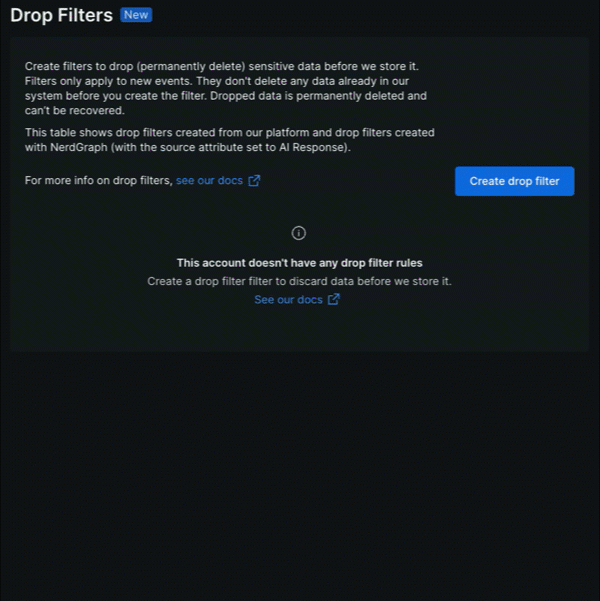중요
As of May 21, 2025, new customers will no longer be able to use NRQL drop rules through the AI Monitoring UI. Instead, customers can use New Relic Pipeline Control, which offers Pipeline cloud rules as a replacement for NRQL drop rules. The pipeline gateway can also assist with data management.
NRQL drop rules will be end-of-life on June 30, 2026.
You have two options for dropping sensitive AI data before you send it to New Relic. This doc guides you through these two methods so you can have better control over the kinds of data the agent collects.
Disable ai.monitoring.record_content.enabled
When you disable ai_monitoring.record_content.enabled, event data containing end user prompts and AI responses won’t be sent to NRDB. You can read more about agent configurations at our AI monitoring configuration doc.
Create drop filters
주의
Use caution when deciding to drop data. The data you drop is not recoverable. Before using this feature, review your data compliance responsibilities.
A single drop filter targets a specified attribute within one event type, but sensitive information from a single AI interaction is stored in multiple events. To drop information before it enters NRDB, you need six separate drop filters.

From one.newrelic.com > All capabilities > AI monitoring > Drop filters: To create a drop filter, select the events that may contain sensitive data, then choose the Regex that corresponds with the type of data you'd like to drop.
- Go to one.newrelic.com > All capabilities > AI monitoring > Drop filters, then click Create drop filter.
- Create a filter name. We recommend creating names based on the information dropped, like "credit card", "emails", "addresses", and so on.
- Choose the events you want to drop information from, or choose to drop from all events.
- Assign regex to the drop filter. Keep in mind that while you can select multiple events when creating a set of drop filters, you can only select one regex type per filter creation.
- Repeat the above steps for other kinds of information you want to drop. For example, if you assigned regex to your first set to drop credit card information, then your next set should drop attributes for another kind of information.
How drop filters work
In a typical AI interaction, a prompt or request undergoes certain processes (like embedding) that are recorded as discrete events. For example, let's say a customer requests a street address on file. The model processes the prompt, which pulls additional context through various services and databases. Your AI assistant then returns with a response that contains the requested information.
A drop filter can contain three parts:
- Events: A stored record from an interaction within your system.
- Regex: A string of characters and operators that corresponds to kinds of information.
- Matching criteria (optional): A NRQL clause that adds specificity to the drop filter. For example, if you only want to drop data from
openai, you can addvendor IN ('openai')
A drop filter evaluates data forwarded by the agent within the data ingest pipeline so sensitive information can be dropped.
Regex
Since the agent's default behavior is to capture all parts of event data before sending it to New Relic, you need to direct the ingest pipeline to match sensitive information with regex. By targeting an attribute with regex, you can still capture the event itself without storing sensitive information in our databases.
Refer to the regex below to start building your first queries:
Your data compliance responsibilities
New Relic can't guarantee that this functionality completely resolves your data disclosure concerns, nor can we provide support for building out your NRQL queries. We recommend that you:
- Review your drop filters and confirm they're accurately identifying and discarding the data you want dropped.
- Check that your drop filters are still dropping sensitive information after you've created them.
While drop filters help ensure that personal information about your end users aren't stored in NRDB, creating the rules themselves imply the kinds of data you maintain, including the format of your data or systems. This is important when determining control permissions for certain users in your org, as certain permissions let users view and edit all information in the rules you create.
What's next?
Now that you've secured your customer's data, you can explore AI monitoring:
- Learn to explore your AI data.
- Want to adjust your data ingest? Learn about how to configure AI monitoring.
- Did you enable logs? Learn how to obfuscate sensitive information from your logs, or remove entire log messages if they contain sensitive information.